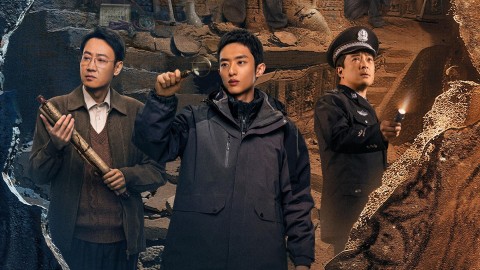Episode Summary
Huanan Wang's attempt to confess to Liu Shusheng is interrupted by a fake police raid, forcing him to flee with Mu Jianhui's help. The police team, led by Qi Dacang, investigates the black pottery figures (Hei Taoyong), with Fang Kun suggesting they originate from an imperial tomb. Thermoluminescence tests reveal a 400-year age gap between the male and female figures. Fang Kun secretly takes a sample from a figure and, after research, theorizes they were fire-damaged and came from the Zi Mausoleum. His unauthorized methods anger Zan Maochang, a senior archaeologist, who dismisses his theory and expels him. Meanwhile, Qi Dacang's investigation into local tomb patrols leads him to Yin Village. Fang Kun, independently investigating there, is mistaken for a tomb raider by Yan Shoucun but is cleared by Qi Dacang. He stays with Qi Dacang's family. The next day, Yan Shoucun helps Fang Kun explore Fenghuang Mountain, while Qi Dacang's interrogation of a tomb raider yields no results.

Spoiler Alert
Things kicked off with Huanan Wang on the verge of spilling the beans to Liu Shusheng, clearly spooked by his threats. But just as he was about to confess, BAM! Yan Xiaowu, posing as a cop, bursts in for a "room check." Naturally, this sent our two dealmakers scrambling. The deal was off, and they bailed, with Huanan Wang, still shaking, getting a timely rescue from Mu Jianhui, who whisked him away and drove him out of Qin Chuan territory.
Meanwhile, Qi Dacang rallied his team for a case analysis. He laid out two main lines of inquiry: keep hunting for Huanan Wang and keep a close watch on those recently discovered tomb raiding tunnels (which they call "Daodong"). Fang Kun chimed in with a sharp idea that Qi Dacang liked: since the black pottery figures (Hei Taoyong) were clearly high-status burial goods, they probably came from an imperial tomb. Narrowing it down to emperor or empress tombs would be key.
But then, the thermoluminescence test results threw a wrench in the works: the male and female figures were a whopping 400 years apart! This sent Qi Dacang and Yang Qingshi rushing off to consult an expert, Zhang Fengchun. However, Zhang Fengchun was super cautious and didn't give them a straight answer. Frustrated, Qi Dacang decided to bring Fang Kun, Luo Qing, and Guo Shilin into the think tank.
Fang Kun, ever the opportunist, sneakily wiped the female figure with a white cloth when no one was looking, snagging some black residue. He showed the sample to Luo Qing and Guo Shilin, asking them to keep it on the down-low, then bee-lined for the library. His research led to a bold hypothesis: if the Hei Taoyong had been through a fire, historical records of such an event might point to their origin.
Enter Zan Maochang, a big shot in the archaeology world, who personally inspected the figures and was seriously impressed by their craftsmanship. Fang Kun, after burning the midnight oil, came to a critical conclusion: the male figure was Western Jin, the female Western Han, and both were likely fire-damaged. He theorized they originated from the Zi Ling (Zi Mausoleum). Plot twist! As Fang Kun presented his findings, he realized Zan Maochang was in the room. To back up his theory, Fang Kun, in the heat of the moment, confessed to taking the sample without permission. Zan Maochang. Was. Furious. He kicked Fang Kun out on the spot.
Later, back at the Yangling archaeological base, Zan Maochang gave Fang Kun, Luo Qing, and Guo Shilin a serious dressing-down. He hammered home that relying on gut feelings was just "empiricism" and that archaeology is an evidence-based science, not guesswork. He acknowledged Fang Kun was smart but warned him not to let his cleverness lead him astray.
While all this was happening, Qi Dacang and Yang Qingshi were over at the Ba Liu Cultural Relics Management Office, investigating. They found out the guy in charge, Lao Tang, wasn't doing his patrols of the mausoleum area as often as required. Lao Tang blamed staff shortages and the long distances, explaining he'd copied Yin Village’s system of using "mass cultural relic protectors." And guess who Yin Village’s protector was? Yan Shoucun.
Fang Kun, still salty about his theory being shot down, wasn't ready to give up. He hopped on his bike and secretly headed to Yin Village to do some solo investigating. Bad move. Yan Shoucun spotted him and, mistaking him for a tomb raider, promptly captured him. Yan Shoucun didn't mess around: he tied Fang Kun up, gagged him, and hauled him off to the village Party branch office.
Luckily, the village secretary, Qi Youliang, stepped in to mediate and called Qi Dacang to clear things up. Qi Dacang, who was already having a bad day after getting an earful from his superiors thanks to Lao Tang's complaints, rushed over to Yin Village and vouched for Fang Kun. Fang Kun claimed he was there to investigate the Hei Taoyong, but Qi Dacang saw right through him – he knew Fang Kun was mostly just trying to prove he was right. Qi Dacang asked Qi Youliang if there were any Daodong nearby; Qi Youliang hadn't heard of any. That night, Qi Dacang took Fang Kun home with him, and Qi Youliang even helped find Fang Kun's bike. So, Fang Kun ended up crashing at the Qi residence.
The next day, once Yan Shoucun understood what Fang Kun was really up to, he actually offered to drive him to Fenghuang Mountain. Despite not having a lot of formal education, Yan Shoucun showed a genuine passion for protecting cultural relics, and Fang Kun patiently explained some of the finer points of tomb structures to him.
Meanwhile, Qi Dacang was trying to squeeze information out of a known tomb raider nicknamed "Xiao Lingtong" (Little Know-It-All), but the guy just played dumb. The case hit another wall.
